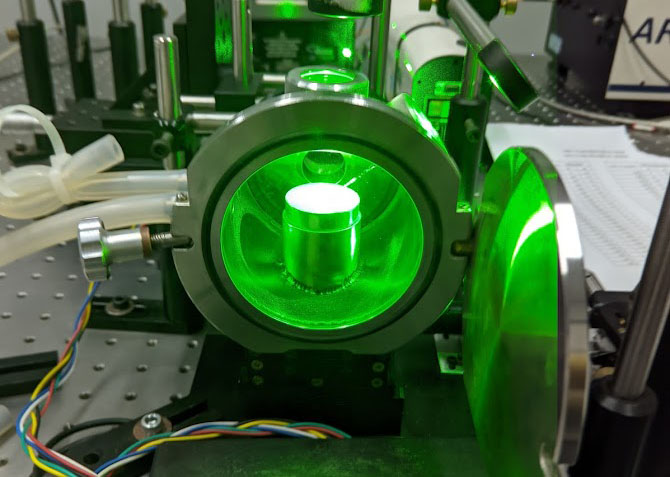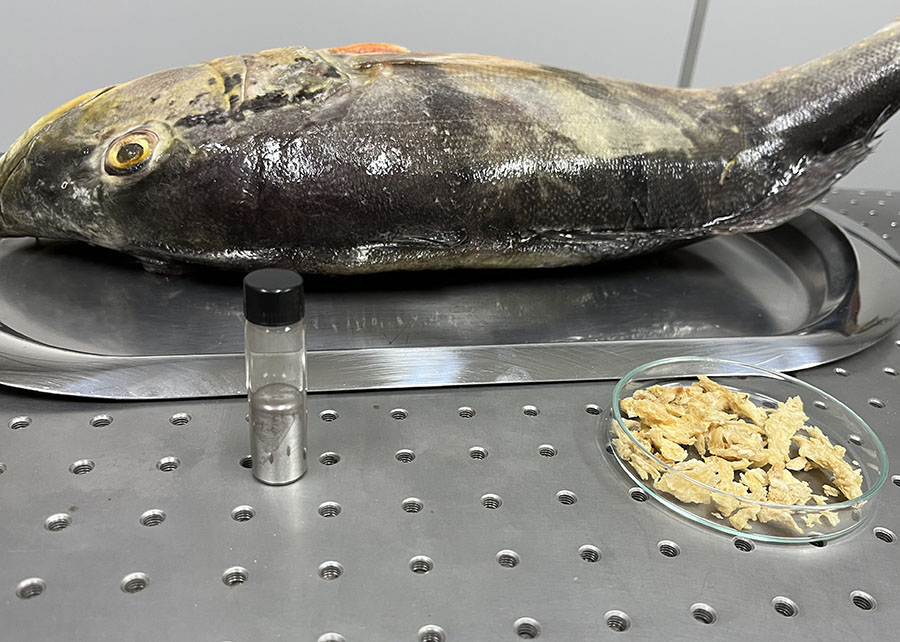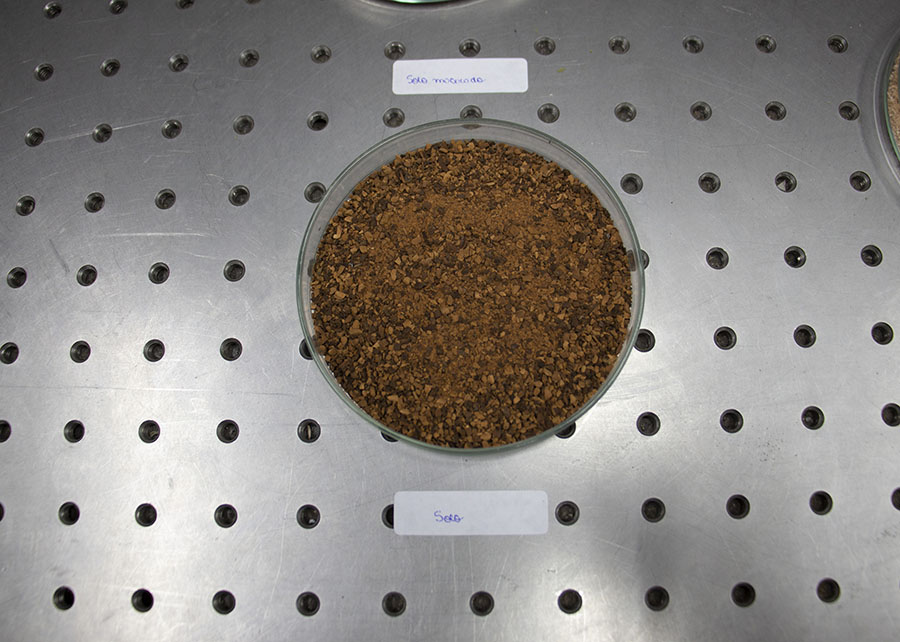Embrapa and USP developed a plasma physics-based model that can detect mercury both in soils and in leachates. The models are aimed at calibrating the laser-induced breakdown spectroscopy (LIBS) technique, so that the same model can analyze different types of samples. The study improved the detection limit of the double-pulse LIBS technique, increasing its accuracy and sensitivity. The work paves the way for improving the LIBS technique, optimizing it for each type of sample and for each element to be detected. Mercury is a chemical element that is difficult to measure in samples. Researchers from Embrapa Instrumentation and from the University of São Paulo's Lorena School of Engineering (EEL/USP) have developed a calibration model (see explanation below) that can quantify mercury in landfill leachates and in certified soil samples. The model calibrates the laser-induced breakdown spectroscopy (LIBS) technique with a soil sample. This is an unprecedented feat in the world, as it is the first time that a research group has been able to calibrate the technique with a sample type and then apply it to another. Despite being considered a powerful technique, LIBS has low sensitivity to some elements, one of which is mercury. In order to overcome this obstacle, the researchers used a double pulse LIBS system (DP-LIBS) developed in a ground-breaking way in Brazil, at Embrapa Instrumentation, with parameters that were optimized for each of the two samples – soil and leachate. One of the main advances of the study was to improve the DP-LIBS system's detection limit for mercury, making it more accurate and sensitive than conventional LIBS systems. What are calibration models? Calibration models relate the signal measured by the technique to the concentration of the element of interest. Once calibrated, the technique allows the quantification of the element of interest in other samples. In this study, the researchers developed a model that relates the collected signal to the one predicted by statistical mechanics and quantum mechanics equations. The greatest research challenge was to have the same measurement protocol be used to analyze different types of samples. In addition, the model managed to correct data variations caused by experimental conditions. The study demonstrated that it is possible to optimize the LIBS system for each sample type, an important step for the quantification of mercury at low concentrations. Potential of the method According to the study coordinator, Embrapa researcher Paulino Ribeiro Villas-Boas, the aim was to confirm a theory, the possibility of using the LIBS technique to measure different sample types like soil and leachate with the same model. For him, the new model opens up new possibilities for analyses using LIBS. “The result indicates that the model has the potential not only to reduce matrix effects but also to compensate for variations in LIBS system optimization for either matrix (soils and leachates), thus allowing the system to be optimized for each type of sample and for each element,” the researcher restates from the paper. “The effects on sample types caused by their physicochemical properties lead to variations in plasma parameters and in emission line intensities, and can compromise the reliability of the results,” explains EEL/USP professor Carlos Renato Menegatti. He said that while the samples have distinct physicochemical characteristics, the extent to which those differences could affect the intensities of the mercury emission line was not known. Picture above by Luis Borduchi What is LIBS? Laser-Induced Breakdown Spectroscopy (LIBS) is an analytical chemistry technique that can detect and quantify any element of the periodic table. The technique does not require chemical reagents or sample preparation, making it ideal for large-scale, low-cost, fast and accurate analyses that do not generate toxic waste. Therefore, it offers enormous potential for agroenvironment analysis. Meanwhile conventional methods use chemical reagents to extract the elements, need sample preparation and are slower. In the study, the researchers adjusted the LIBS system for each type of sample in order to obtain accurate measurements of mercury concentrations ranging from 50 to 1,000 parts per million (ppm). According to Villas-Boas, variations in the chemical composition of the samples and in the DP-LIBS system parameters hinder the development of quantification models. He recalls that one of the biggest hindrances is having a single model for soils, considering that they have very diverse chemical and physical compositions. “So we worked with models based on physical principles, on local thermodynamic equilibrium, and on distributions of the energy states of atoms and ions, for instance. We started from physical models of statistical mechanics and quantum mechanics, showing that it is possible to calibrate the system with one type of matrix and apply it to another”, the researcher reports. Application for soils and leachates The analyzes were performed with samples of 540 mg of soil, from São Carlos, SP, and a sample of 500 mg of leachate collected from the landfill in Cachoeira Paulista, SP. To detect the presence of mercury, the leachate underwent an oven-drying process and the dry residue was transformed into a 5-millimeter solid pellet, as was done with the soil sample as well. “When the laser strikes the surface of the pellet made of soil or leachate, the material absorbs energy and undergoes a process of heating and breakdown of molecules, generating a plasma with an initial temperature of around 50,000 K (above the temperature on the surface of the Sun, which is approximately 5,800 K),” details Embrapa researcher Débora Milori. According to her, the light emitted by this plasma is captured by a spectrometer, which allows the identification of the elements present in the sample based on their emission lines. Since the intensity of the emission lines is specific to each element, the amount of heavy metals like mercury can be measured in just a few minutes. “In the current study, we were not only able to reduce the matrix effects, but we also corrected the differences in the experimental conditions under which the sets of samples were measured,” says Luis Carlos Leva Borduchi, a student advised by VillasBoas at Embrapa Instrumentation's National AgroPhotonics Laboratory (Lanaf). Professor Menegatti recalls that mercury is one of the worst contaminants for health and the environment, and it was recently detected in fish consumed by the population in six Brazilian states. Because of such issues, the Brazilian legislation determines thatmercury concentrations in landfill leachates cannot exceed 0.5 ppm, but many often reach 160 ppm. The LIBS technique can contribute to this stage of the process, ensuring the safe levels established by law. “We attempted to make something that could be measured regardless of the type of sample and thus solve a general environmental problem, not only for this region but for the whole world”, the professor celebrates. The researchers suggest complementary studies to confirm the results of the work and expand the use of the technique and the models to other elements, sample types and measurement conditions. At the moment, the team is working on new methods to further reduce the detection limit of the LIBS technique to quantify mercury. Photo by: Joana Silva Work published in an international journal The study, which was published in the Royal Society of Chemistry Journal of Analytical Atomic Spectroscopy (JAAS), demonstrated that the models developed have potential for the accurate quantification of mercury in soil samples and samples of leachates, also known as landfill sludges. The paper was authored by researchers from Embrapa Instrumentation Débora Milori and Paulino Ribeiro Villas-Boas, by the student at the University of São Paulo São Carlos Physics Institute (IFSC/USP) Luís Carlos Leva Borduchi, and by professors Carlos Renato Menegatti and Hélcio José Izário Filho, from the same university's Lorena School of Engineering (EEL/USP). The study was also funded by the São Paulo State Research Foundation (Fapesp) and the National Council for Scientific and Technological Development (CNPq). Photo: Guilherme Lima (soil sample)
Researchers from Embrapa Instrumentation and from the University of São Paulo's Lorena School of Engineering (EEL/USP) have developed a calibration model (see explanation below) that can quantify mercury in landfill leachates and in certified soil samples. The model calibrates the laser-induced breakdown spectroscopy (LIBS) technique with a soil sample. This is an unprecedented feat in the world, as it is the first time that a research group has been able to calibrate the technique with a sample type and then apply it to another.
Despite being considered a powerful technique, LIBS has low sensitivity to some elements, one of which is mercury. In order to overcome this obstacle, the researchers used a double pulse LIBS system (DP-LIBS) developed in a ground-breaking way in Brazil, at Embrapa Instrumentation, with parameters that were optimized for each of the two samples – soil and leachate. One of the main advances of the study was to improve the DP-LIBS system's detection limit for mercury, making it more accurate and sensitive than conventional LIBS systems.
What are calibration models? Calibration models relate the signal measured by the technique to the concentration of the element of interest. Once calibrated, the technique allows the quantification of the element of interest in other samples. In this study, the researchers developed a model that relates the collected signal to the one predicted by statistical mechanics and quantum mechanics equations. |
The greatest research challenge was to have the same measurement protocol be used to analyze different types of samples. In addition, the model managed to correct data variations caused by experimental conditions. The study demonstrated that it is possible to optimize the LIBS system for each sample type, an important step for the quantification of mercury at low concentrations.
 Potential of the method
Potential of the method
According to the study coordinator, Embrapa researcher Paulino Ribeiro Villas-Boas, the aim was to confirm a theory, the possibility of using the LIBS technique to measure different sample types like soil and leachate with the same model.
For him, the new model opens up new possibilities for analyses using LIBS. “The result indicates that the model has the potential not only to reduce matrix effects but also to compensate for variations in LIBS system optimization for either matrix (soils and leachates), thus allowing the system to be optimized for each type of sample and for each element,” the researcher restates from the paper.
“The effects on sample types caused by their physicochemical properties lead to variations in plasma parameters and in emission line intensities, and can compromise the reliability of the results,” explains EEL/USP professor Carlos Renato Menegatti. He said that while the samples have distinct physicochemical characteristics, the extent to which those differences could affect the intensities of the mercury emission line was not known.
Picture above by Luis Borduchi
What is LIBS? Laser-Induced Breakdown Spectroscopy (LIBS) is an analytical chemistry technique that can detect and quantify any element of the periodic table. The technique does not require chemical reagents or sample preparation, making it ideal for large-scale, low-cost, fast and accurate analyses that do not generate toxic waste. Therefore, it offers enormous potential for agroenvironment analysis. Meanwhile conventional methods use chemical reagents to extract the elements, need sample preparation and are slower. |
In the study, the researchers adjusted the LIBS system for each type of sample in order to obtain accurate measurements of mercury concentrations ranging from 50 to 1,000 parts per million (ppm). According to Villas-Boas, variations in the chemical composition of the samples and in the DP-LIBS system parameters hinder the development of quantification models.
He recalls that one of the biggest hindrances is having a single model for soils, considering that they have very diverse chemical and physical compositions. “So we worked with models based on physical principles, on local thermodynamic equilibrium, and on distributions of the energy states of atoms and ions, for instance. We started from physical models of statistical mechanics and quantum mechanics, showing that it is possible to calibrate the system with one type of matrix and apply it to another”, the researcher reports.

Application for soils and leachates
The analyzes were performed with samples of 540 mg of soil, from São Carlos, SP, and a sample of 500 mg of leachate collected from the landfill in Cachoeira Paulista, SP.
To detect the presence of mercury, the leachate underwent an oven-drying process and the dry residue was transformed into a 5-millimeter solid pellet, as was done with the soil sample as well. “When the laser strikes the surface of the pellet made of soil or leachate, the material absorbs energy and undergoes a process of heating and breakdown of molecules, generating a plasma with an initial temperature of around 50,000 K (above the temperature on the surface of the Sun, which is approximately 5,800 K),” details Embrapa researcher Débora Milori.
According to her, the light emitted by this plasma is captured by a spectrometer, which allows the identification of the elements present in the sample based on their emission lines. Since the intensity of the emission lines is specific to each element, the amount of heavy metals like mercury can be measured in just a few minutes.
“In the current study, we were not only able to reduce the matrix effects, but we also corrected the differences in the experimental conditions under which the sets of samples were measured,” says Luis Carlos Leva Borduchi, a student advised by VillasBoas at Embrapa Instrumentation's National AgroPhotonics Laboratory (Lanaf).
 Professor Menegatti recalls that mercury is one of the worst contaminants for health and the environment, and it was recently detected in fish consumed by the population in six Brazilian states. Because of such issues, the Brazilian legislation determines thatmercury concentrations in landfill leachates cannot exceed 0.5 ppm, but many often reach 160 ppm. The LIBS technique can contribute to this stage of the process, ensuring the safe levels established by law.
Professor Menegatti recalls that mercury is one of the worst contaminants for health and the environment, and it was recently detected in fish consumed by the population in six Brazilian states. Because of such issues, the Brazilian legislation determines thatmercury concentrations in landfill leachates cannot exceed 0.5 ppm, but many often reach 160 ppm. The LIBS technique can contribute to this stage of the process, ensuring the safe levels established by law.
“We attempted to make something that could be measured regardless of the type of sample and thus solve a general environmental problem, not only for this region but for the whole world”, the professor celebrates.
The researchers suggest complementary studies to confirm the results of the work and expand the use of the technique and the models to other elements, sample types and measurement conditions. At the moment, the team is working on new methods to further reduce the detection limit of the LIBS technique to quantify mercury.
Photo by: Joana Silva
 Work published in an international journal Work published in an international journal
The study, which was published in the Royal Society of Chemistry Journal of Analytical Atomic Spectroscopy (JAAS), demonstrated that the models developed have potential for the accurate quantification of mercury in soil samples and samples of leachates, also known as landfill sludges. The paper was authored by researchers from Embrapa Instrumentation Débora Milori and Paulino Ribeiro Villas-Boas, by the student at the University of São Paulo São Carlos Physics Institute (IFSC/USP) Luís Carlos Leva Borduchi, and by professors Carlos Renato Menegatti and Hélcio José Izário Filho, from the same university's Lorena School of Engineering (EEL/USP). The study was also funded by the São Paulo State Research Foundation (Fapesp) and the National Council for Scientific and Technological Development (CNPq). Photo: Guilherme Lima (soil sample) |

 Potential of the method
Potential of the method Professor Menegatti recalls that mercury is one of the worst contaminants for health and the environment, and it was recently detected in fish consumed by the population in six Brazilian states. Because of such issues, the Brazilian legislation determines thatmercury concentrations in landfill leachates cannot exceed 0.5 ppm, but many often reach 160 ppm. The LIBS technique can contribute to this stage of the process, ensuring the safe levels established by law.
Professor Menegatti recalls that mercury is one of the worst contaminants for health and the environment, and it was recently detected in fish consumed by the population in six Brazilian states. Because of such issues, the Brazilian legislation determines thatmercury concentrations in landfill leachates cannot exceed 0.5 ppm, but many often reach 160 ppm. The LIBS technique can contribute to this stage of the process, ensuring the safe levels established by law.
